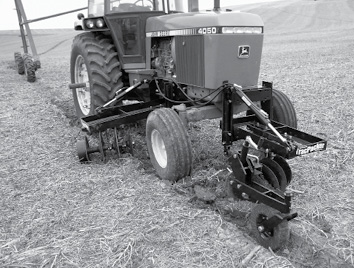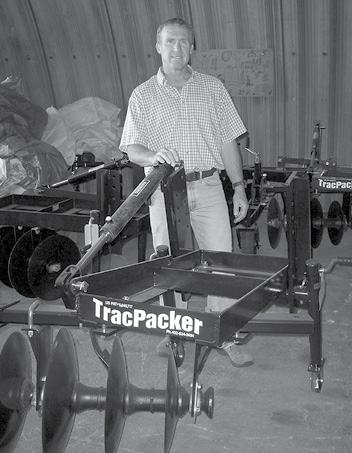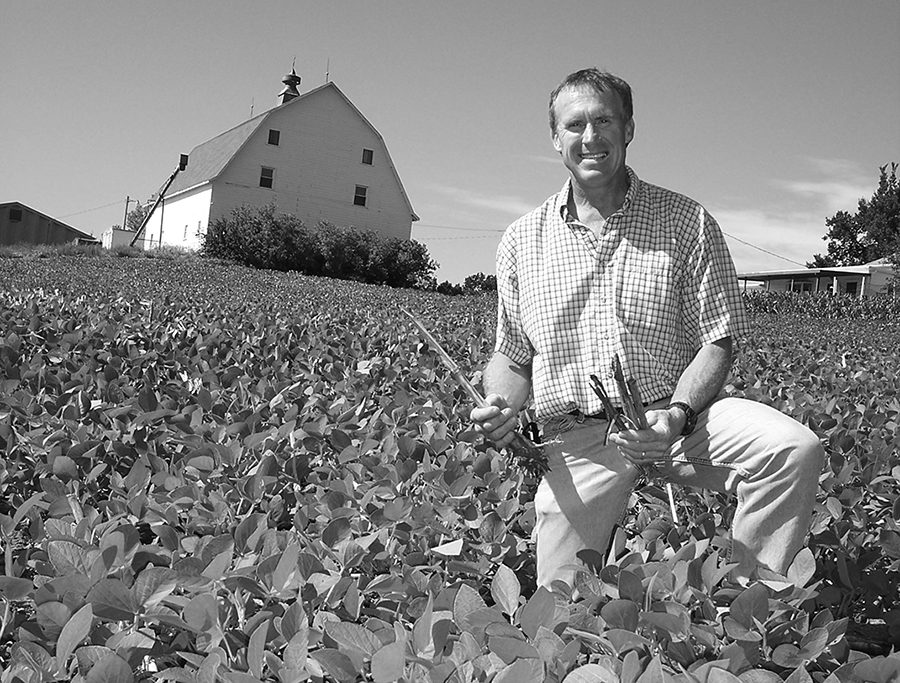Check The Specs...
NAME: Dan Gillespie (no-till farmer and state no-till specialist for NRCS)
LOCATION: Meadow Grove, Neb.
YEARS OF NO-TILLING: 21 (17 years continuous no-till)
ACRES NO-TILLED: 700 (55% center-pivot irrigated)
CROPS NO-TILLED: Corn, soybeans, cover crops (wheat, rye, oilseed radishes, CANULA, winter lentils and legumes)t
Most no-tillers can recall a time (or incident) when the “light went on” — when no-till became an obvious option. For me, that happened in 1986 during a dry spring.
Incorporating herbicide with a field cultivator dried out the soil about 4 inches deep, way below the seed zone. So we delayed planting, hoping for a replenishing rain. Meanwhile, a neighbor who ridge-tilled got his crop in and up in 5 days while we sat on our hands waiting for Mother Nature to cooperate.
We had been reading a lot about the growth of no-tillage in the central Corn Belt, but questioned how no-till would work in a drier area of northeast Nebraska with a mix of irrigated and dryland fields. My cropland is primarily Nora Crofton silty clay loam soils on 4% to 16% slopes.
We started cautiously, no-tilling 25 acres of corn into soybeans the next spring. The no-tilled corn performed about the same as the tilled field, so we boosted the no-till test to 50 acres in 1988. And, when I compared the yields with conventional till across a center-pivot-irrigated field, no-till corn shelled out 16 bushels more per acre!
I presumed the only reason was that no-till plants were healthier, stayed alive longer and thus filled out bigger ears. After that, I never touched another acre of soybean ground with a field cultivator or other tillage tool.
In 1991, I no-tilled my first soybeans into corn stalks with concern about how my old John Deere 6600 combine would handle the residue left from 200-bushel corn. I was pleasantly surprised.
The trash had already started to deteriorate below the canopied soybeans by harvest. Because there was no dust from running root balls through the machine, the beans were exceptionally clean. The combine handled the increased residue with no problem.
We evolved to a continuous no-till system on all of our acres by 1991.
NEIGHBOR NETWORK
At that time, there were few no-tillers in northeast Nebraska. And, we didn’t yet have the wisdom of educators like University of Nebraska agricultural engineer Paul Jasa, or state and national meetings, such as the National No-Tillage Conference, where no-tillers could swap ideas and problems.
Fortunately, I was able to “network” with Rod Zessin, a farmer who started no-tilling in 1990 right across the road. Having someone to talk to while we transitioned to no-till prevented a lot of mistakes.
Rod and I immediately saw four big advantages of no-till:
1. Erosion control.
2. Fuel efficiency.
3. Time savings.
4. Reduced machinery hours.
On a humorous note, as a 30-plus-year-old single guy, my priorities were not sitting on a tractor tilling the soil. So, cutting my time in the field by more than half was a big seller for me. Now married with five daughters, the time I save is much more precious. Quality of life becomes a big incentive to never go back to tillage.
About the third year into no-till soybeans, we noticed a drop in yield of about 2 bushels per acre compared to reported yields from neighbors. Rod and I talked about it and concluded we were willing to give up 2 bushels if it meant we could plant next spring without spending any money for tilling.
Later, we found the problem was an imbalance in the carbon-to-nitrogen ratio. Soil microbes were taking nitrogen from the soil to digest corn stalks.
Adding a little nitrogen fertilizer to the bean crop solved the problem. And once the biological systems were in place to digest the residue without robbing nitrogen from the crop, there was no yield drag.
LEARNING ABOUT PLACEMENT
Seed Depth. During the first 7 years, we changed or tweaked something on the planter every year. We started no-tilling with a John Deere 7000 six-row planter, later trading it for a John Deere 1770 12-row machine. We went from coulters to trashwheels, running them from too deep to too shallow in an effort to find the magic answer.

Then, 4 years ago, Paul Jasa convinced me to lift the trashwheels up and go from a 1.5- to a 2.5-inch planting depth. Since that change, I’ve had the most consistent and uniform stands since I started no-tilling. Paul preaches that uniformity of stand is what counts and planting deeper is the key.
Another bonus of deeper planting is that ground squirrels don’t seem to be able to find the corn seed. I don’t know why, unless they just can’t smell it.
But I have convincing photos of a ground squirrel burrow with a perfect stand of corn right beside it. As many no-tillers know, ground squirrels and gophers can be a menace in no-tilled corn.
Fertilizer. Pop-up fertilizer in no-tilled fields is good insurance against cold, wet springs in northeast Nebraska. Placing nitrogen and phosphorus next to the seed gives it a boost, as the roots seek the starter.
I move the single-disc openers over 4 inches to avoid making two slots within a 3-inch zone, which could create a concentration of water flow that’s enough to wipe out the seed trench on our hilly fields.
The pop-up fertilizer in the seed furrow gets the plants to the point where roots can grow out and feed on the starter application.
Pop-up starter doesn’t add to fertilizer costs, since if the spring turns out warm and dry, the total amount of fertilizer we use is the same — just applied in a different place.
Most of our fertilizer goes on in a weed-and-feed, pre-emergence spray applied by the local co-op. I mix 30 gallons of 32% liquid nitrogen (105 pounds of nitrogen) with a half rate of herbicide.
We do our own post-emergence applications with a 1,000-gallon, heavy-duty, pull-type Fast sprayer. It has 60-foot, flip-fold booms and we can pull it at 7 to 9 mph with a 1983 100-horsepower 4050 John Deere tractor with no problems.
Because of concerns that glyphosate abuse could very well catch up with us, we grow Roundup Ready soybeans but have stayed with conventional corn hybrids. So far, non-GMO varieties have yielded comparably with triple-stack hybrids grown within a mile or two of our farm.
We’re fortunate that a local elevator with Mitsubishi Corp. contracts and exports non-GMO corn to Japan. This year, they’re paying a 57-cent-per-bushel premium. It takes a little more time and investment to maintain purity, but it’s worth it.
BIG BOOST FOR NO-TILL
One of the most successful opportunities for increasing the number of no-till acres in our region came in 1999 when the Lower Elkhorn Natural Resource District leaders (LENRD) asked for ideas that might encourage better conservation practices in an area where farmers were not doing much terracing. LENRD serves all or part of 15 counties in northeastern and central Nebraska. (I’ve been a NRCS technician, as well as a no-till farmer, since 1987.)

Since NRCS believes that continuous no-till provides erosion control equal to a terrace system, we suggested a cost-share program in which farmers would be paid $10 per acre to shift 160 acres into no-till.
We limited the No-Till Incentive Program (NTIP) to a 5-year contract, as that’s how long it takes to improve soil structure and increase rainfall infiltration. We were sure that if farmers saw the benefits of no-till over that time, they would never revert to tillage.
In the first year of the NTIP, we signed up 65 farmers who contracted about 8,400 acres. Over the next few years, participants grew to 200 with more than 29,000 acres enrolled.
We opened up enrollment to existing no-tillers, partly to establish a database of experience with which new no-tillers could rub elbows. We were frankly surprised to find guys with 20 years of no-till experience joining up. Each participant was required to attend two educational workshops per year.
We’ve grown the program over the years, leveraging it with federal EQIP dollars so that a participating farmer can receive about $10,000 on 160 acres over a 6-year period. Currently, 138 farmers have 13,177 acres under contract. Overall, 292 farmers with 37,174 acres are in or have been through the program.
And here’s a big bonus! We estimate that they no-till 6.6 acres of additional land for every acre contracted. That amounts to a total of more than 282,500 acres of continuous no-till.
We were pleased when the program was recognized at the 2005 National No-Tillage Conference with the No-Till Innovator Award from Syngenta and No-Till Farmer.
COVER CROP LESSONS
After observing my no-till fields for more than 2 decades — as well as thousands of new acres transitioning to no-till — evidence is strong that corn and soybeans are not a diverse enough rotation for success.
We can’t grow crops only 4 or 5 months of the year and expect to build the soil. We need to emulate Mother Nature by planting a cover crop to fill the interval between harvest and planting of our commercial crops.
Clearly, having some type of vegetation growing in the soil as long as weather will allow is the key to reversing the soil degradation that farmers have created through many years of aggressive tillage. It boils down to acknowledging that the soil is a living resource. It can feed itself and rebuild the fertile humus, but we have to give it that opportunity.
The potential rewards are staggering, in terms of soil nutrients — a 1% increase in soil organic matter from no-tilling provides on a per-acre basis 10,000 pounds of carbon; 1,000 to 1,400 pounds of nitrogen; 167 to 200 pounds of phosphorus; 250 to 300 pounds of calcium; 111 to 133 pounds of magnesium; and 123 to 145 pounds of sulfur.

The more vegetation grown in the soil, the quicker you’ll see the boost in organic matter.
To evaluate cover cropping, the LENRD initiated 3 years ago a cost-share incentive program where 40 acres of cereal rye seed is flown onto highly erodible soybean ground.
We’re expanding this into a pilot program with 15 farmers by seeding rye, oilseed radishes, winter lentils and rapeseed in the fall. Our goal is to find out how to manage this “cocktail” so that it will sequester the most nitrogen for the next corn crop.
If this program works after 3 years, we will have devised a system to enhance erosion control as well as soil fertility. Considering the high price of commercial fertilizers, that would be a big win for our no-tillers.
On my own farm, I have used both wheat and rye cover crops and will be testing the “cover crop cocktail” this fall. In one case, we bought a farm in 2008 that we had farmed for 17 years. In 2007, it was in winter wheat.
We double-cropped soybeans and then flew rye into the soybeans just before harvest, so we had something growing in the soil every minute we could. I’m completely convinced that should be the goal of all no-tillers.
TIME TO INVENT
Thanks to the time-saving benefits of no-till, I’ve developed a sideline business building and marketing a center-pivot track filler called the TracPacker.
I daydreamed about the TracPacker design for 3 years as I harvested 200-bushel corn with that old John Deere 6600 combine, trudging along about 2 mph because of the deep ruts created by the center-pivot tires. Every time I bounced over a deep pivot track, I expected the back axle to snap off.
In the fall of 1994, I brought my dream to reality. My dad and I dropped every bolt and nut out of an old IHC 37 disc. I had already determined which angle irons and pieces of the structure I was going to use.
The resulting prototype consisted of a gauge wheel that runs in the pivot track to regulate the proper amount of soil moved and then is feathered into the track with a disc gang.
The front tire of the tractor packs the soil into the bottom of the track, making room for a second movement of soil by a disc gang mounted between the front and rear tires. A rear tire finishes the packing.
I tested the first prototype on my own three center pivots and after a couple years, loaned it to neighbors. I knew we had something when they offered to haul grain in exchange for using the TracPacker.
The idea of growing the business really came to life when I showed a video clip of the prototype to a LENRD workshop attended by Univ. of Nebraska Ag Research and Development Center researcher Stuart Hoff. He asked me to build him a machine, so we built four.
(TracPacker frames are built at a Meadow Grove machine shop; the disc blades are stock parts from Case IH.)
We now market about 35 machines each year. We’ve shipped from Ohio to Washington and from North Dakota to Texas. In 2006, we shipped five TracPackers to the Ukraine.
I decided to keep the business a relatively small family farm business because I don’t want the TracPacker business to affect my no-till farming schedule, the NRCS job or my family’s quality of life.
We have met many no-tillers and made many good friends from customers coming to the farm to pick up their TracPacker. On the other hand, it has paid for nice vacations to Mexico and other fun places. And I no longer have to worry about busting combine axles!









Post a comment
Report Abusive Comment